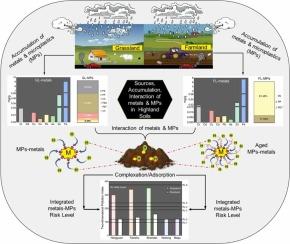An integrated evaluation of potentially toxic elements and microplastics in the highland soils of the northeastern Qinghai-Tibetan Plateau
IF 12.2
1区 环境科学与生态学
Q1 ENGINEERING, ENVIRONMENTAL
引用次数: 0
Abstract
As gateways to the scenic Qinghai-Tibetan Plateau (QTP), some underexplored five grassland (GLs) and three farmland (FLs) soil locations of northeastern counties were investigated. Preliminary detection showed that in the grazing and agricultural soils, elemental concentrations (Fe>Zn>Cr>Cu>Pb>Co>As>Cd) were up to 37 and 10 mg/g, but within the China soil standards, except Cd, while microplastics (MPs) abundances were 200-3,640 and 280-973 particles/kg, respectively. Polypropylene (PP: 40-55%) dominated in GLs mostly as fragments, whereas polyethylene (PE: 72-92%) in FLs as films. Adsorption results demonstrated that potentially toxic elements (PTEs)-MPs' interaction may chiefly depend on their types and speciation in soils, the physiochemical structure of MPs, and surrounding conditions. The integrated two-dimensional risk assessment categorized three of five GLs under Risk Level VI (high pollution), whereas one of three FLs displayed Risk Level III (moderate pollution). Correlation analysis revealed that altitude, organic matter, soil clay content, and precipitation significantly affected PTEs (p≤0.01), whereas MPs were influenced by altitude, soil clay content, precipitation (p≤0.001), and population density (p≤0.05). Comparison with low-land soils globally designated QTP as a vulnerable region to MPs due to the expanding development. Overall, our study provides a data set to understand the pollution scenario of highlands for its targeted management.

求助全文
约1分钟内获得全文
求助全文
来源期刊

Journal of Hazardous Materials
工程技术-工程:环境
CiteScore
25.40
自引率
5.90%
发文量
3059
审稿时长
58 days
期刊介绍:
The Journal of Hazardous Materials serves as a global platform for promoting cutting-edge research in the field of Environmental Science and Engineering. Our publication features a wide range of articles, including full-length research papers, review articles, and perspectives, with the aim of enhancing our understanding of the dangers and risks associated with various materials concerning public health and the environment. It is important to note that the term "environmental contaminants" refers specifically to substances that pose hazardous effects through contamination, while excluding those that do not have such impacts on the environment or human health. Moreover, we emphasize the distinction between wastes and hazardous materials in order to provide further clarity on the scope of the journal. We have a keen interest in exploring specific compounds and microbial agents that have adverse effects on the environment.
 求助内容:
求助内容: 应助结果提醒方式:
应助结果提醒方式:


